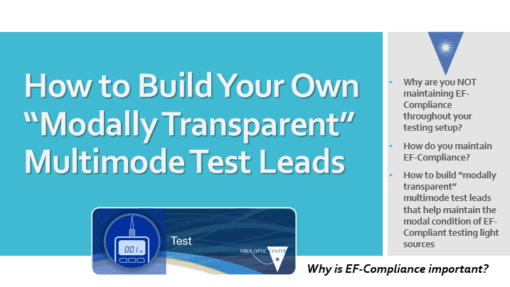I believe every fiber optic manufacturing company should build its own test leads. Of course, these test leads must provide accurate, repeatable Insertion Loss (IL) test results.
This article offers guidance to confidently build and use your own EF-Compliant “modally transparent” test leads (aka reference leads and launch leads).
Briefly, why is EF-Compliance important?
Today, most multimode test systems are designed and built to ensure an EF-Compliant light output. EF-Compliance standards were initiated by IEC to promote standard multimode test launch conditions in order to achieve consistent, repeatable Insertion Loss test results.

EF-Compliant launch conditions reduce occurrence of “overfilled” and “underfilled” launch conditions, both of which lead to inaccurate IL test results:
- Overfilled launch conditions – In an overfilled launch condition, the light power exiting the test lead is spread out, in a large “spot size” – possibly larger than the size of the fiber core. When connected to a device under test (DUT), a significant amount of light power on the outer-diameter of that spot will not couple into the receiving fiber’s core, even if the receiving connection is of perfect quality. The result is increased (falsely poor) Insertion Loss test results.
- Underfilled launch conditions – Conversely, in an underfilled launch condition, the light power exits the test lead in a small “spot size” concentrated in the center of the core. When connected to a DUT, most of the light couples easily into the receiving fiber’s core, even if the two cores are severely misaligned. The result is falsely good Insertion Loss test results.
Keep in mind, the launch conditions of your customers’ transmission equipment are unknown and will vary, depending on type of source (laser or LED) and source manufacturer. The EF-Compliant standard is not intended to standardize the launch condition of end-user transmission equipment, but rather to standardize on cable-assembly manufacturers’ test equipment so that all cable manufacturers’ test results can be compared “apples to apples.”
Chances are, you are NOT maintaining EF-Compliance throughout your testing setup. Here’s why:
Many cable assembly producers go wrong by failing to understand that simply using an EF-Compliant light source is not enough to ensure that the light coming out of the test lead is still EF-Compliant. An EF-Compliant light source ensures that the light exiting the source has a controlled and specific mode condition. It’s up to you, the manufacturer, to ensure your test leads are built with high-quality connectors and fibers to maintain that compliant modal condition.
Connecting a poor-quality test lead (or switch or any other component in a test system) to a light source can significantly alter the modal condition of the light – even if the source itself is truly EF-Compliant. The resulting light that exits the test lead is now uncontrolled and likely not EF-Compliant.
How do you maintain EF-Compliance?
The best way to ensure you maintain EF-Compliance throughout your testing setup is to ensure all fibers within the test system light path (switches, test leads, etc.) are as “modally transparent” as possible. That is, the fibers and connections in the entire light path should be designed to have minimal effect on altering the modal condition of the light input.
All too often, cable assembly producers will build their own multimode test leads using low-cost/low-quality fibers and connectors, without considering how these affect the output modal condition. Ideally, you can directly measure EF-Compliance of your test lead output with commercially available EF meters. The reality, however, is that very few cable assembly houses invest in this equipment. It’s relatively expensive, and manufacturers tend to consider multimode assemblies to be a “lower class” of cable assemblies and not worthy of the attention to testing detail that “high class” singlemode assemblies require. But even without a dedicated EF meter, it is not difficult to build test leads that give high-confidence of maintaining EF-Compliance.
To build “modally transparent” multimode test leads that help maintain the modal condition of EF-Compliant testing light sources, you should:
- Use the highest quality fiber available, polished to industry standards – Most major fiber manufacturers offer a high-quality, metrology-grade multimode fiber. Ask your fiber supplier; they should be familiar with such fiber.
- Terminate these fibers with high-quality connectors – I recommend using premium-grade singlemode connectors on all multimode test leads. These will have sufficient ferrule-hole concentricity and hole ID tolerances. Use connectors with a high-concentricity/low-diameter-tolerance ferrule hole. This is important, not only on the end of the test lead that will be used for testing, but also for the end of the test lead that will be connected to the light source. If those 2 fiber cores are not properly aligned, the modal conditions will be altered.
- Polish the ferrules to comply with standard singlemode end-face geometry and visual inspection criteria – This helps to ensure optimum core-to-core contact in all connector matings.
The bottom line…
You can build – and use with confidence – your own “modally transparent” multimode test leads that sufficiently maintain the modal condition of the input light from an EF-Compliant source. This will give you more accurate and repeatable IL test results, which is the goal!
Additional resources from the FOC team include:
- View Test Technical Solution Content
- View the Glossary, Acronyms, Military Specifications for Connectors
- Q&A Resource: email technical questions to AskFOC@focenter.com



